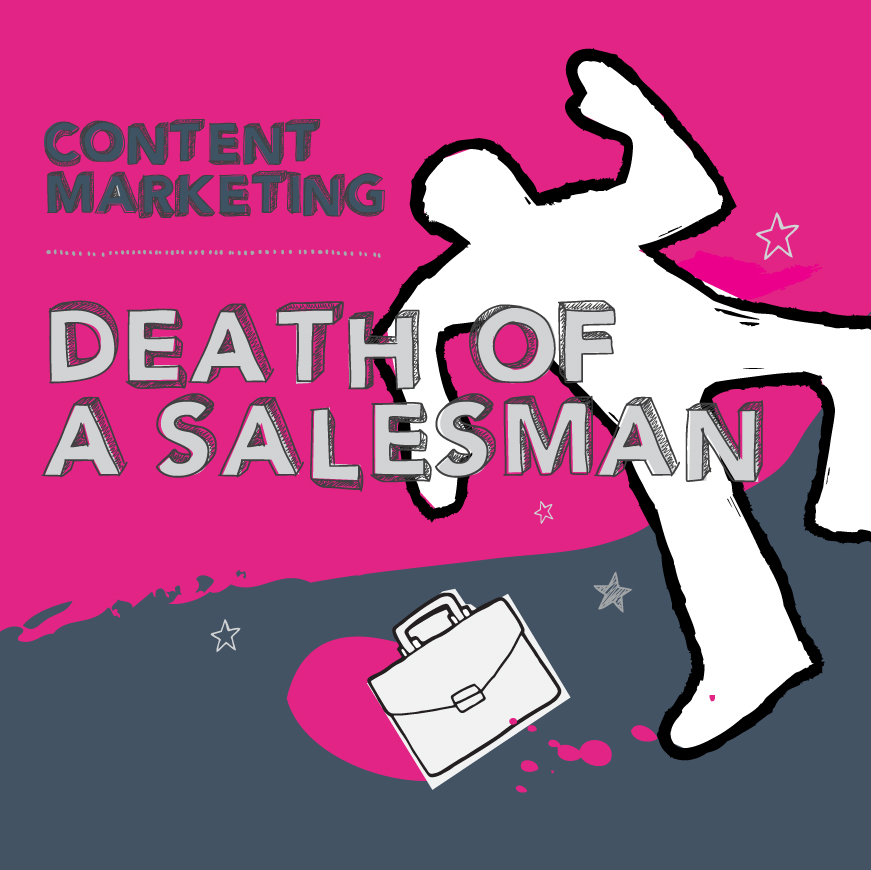
B2B CONTENT MARKETING - CONTENT STRATEGY
Death of a salesman - Part 2
The new era for marketing & sales
In Part 1 – The Age of Disruption – we looked at how disruptive businesses have turned the traditional interaction between sales and marketing on its head and how the relationship of buyer and seller has evolved.
Before the advent of the Internet and search, the salesman was pretty much the sole source of information for buyers throughout their journey to purchase. For every question, such as… “What are this product’s key features? How will it benefit my business? How much does it cost? Why should I buy it from you?”… the answer lay with the salesman. And if the buyer was comparing the market, this process had to be undertaken with more than one potential supplier.
Now all that has changed. Today, buyers are between 55-70% of the way through the buying cycle before they ever directly engage with a brand let alone a salesman. And why and how have they been able to adopt the approach of sourcing and comparing information independently? The answer, of course, is “Content”.
The content connection
Content is now king and the traditional sales approach is an anachronism. But let’s back up a bit. Content marketing is not a silver bullet. Under an avalanche of messages and media, buyers are increasingly desensitized and frustrated by messaging vying for their attention. The result is that only the most relevant messages cut through, with buyers choosing where and when they engage and with placing growing demands on the information they expect to be available to them.
Marketers are recognising that creating content which reflects the audience’s agenda (not just their own) gains traction and engagement faster and more effectively. Those at the frontier of content development have gained a deep understanding of their buyers’ journey and are creating content and communications accordingly. Here we outline the essential elements involved in creating marketing content that really counts.
Be prepared
It’s not just about any marketing content, it’s about content that understands the buyer’s issues, the journey they will take and the questions they will seek answers to. The correct content addresses the same questions the buyer would ask and get answered by a sales person. It’s informed, authoritative and impartial (ish – all content has an agenda).
It’s also vital to organise your marketing in the same way your customers buy from you: align ALL of your marketing behind your customer as they journey from prospect to brand advocate. A survey conducted by the Business Marketing Association concluded that, “The majority of B2B content practices focus too narrowly on early-stage buyer acquisition — which fails to engage buyers throughout their lifetime. To create content that attracts and builds customer relationships throughout the customer life cycle, B2B marketers must make a fundamental shift from writing about features and benefits to delivering valuable information that drives business results.”
Be consistent. Build the story; accompanying each step the buyer takes with another chapter. Those that embrace this concept fastest and most effectively gain an immediate competitive advantage. They empower the buyer, (which the buyer likes) and so help the brand accelerate its position to become the preferred choice.
Content and value at the core
Many associate content marketing with engagement marketing, but it demands a more holistic approach. Content marketing is every communication and message the business conveys; it should intrinsically link to the brand’s central mission, vision, value and values messaging.
Selling is social
Selling has always been social as up until recently it heavily relied on people – it still does, just in a different way. Social media channels have simply extended the places where the selling takes place. Indeed, a recent study published by global market intelligence provider IDC found that 75% of B2B buyers and 84% of C-level executives use social media to make purchasing decisions.
Social media channels empower the buyer through sharing of peer opinions, user experiences, problem solving and free consulting. The buyer can actively participate in the process or simply absorb information that will ultimately inform their opinion. Brands can seed content in these channels to share information and insight and connect with their buying community, thus building trust.
Whilst social media managers and agencies can plan strategies and create content, they are less likely to have the necessary in-depth knowledge to handle social selling – that hybrid of marketing and sales interacting on a wider (yet also one-to-one) basis with “sales content.” This is an arena in which both sales and marketing have a role to play in contributing to discussions and feeding back insight gathered from the different social selling environments, to better inform future working and content development.
Simple sells
Many medium to large businesses face inwards; they organise their marketing around their own agenda. As a result, the brand’s value to its audience often gets lost, important messages become submerged or unnecessarily complicated. Simplicity is hard to achieve in business, it takes time and effort – but the rewards can be massive. Concentrate on explaining your offering and value in simple terms. It starts with your brand and, as its first point of contact, your website.
Marketing technology sells
Marketers now have a wealth of digital channels and marketing technology tools that can be used to augment the selling process. Cross channel analytics enable data to be turned into insight that continues to drive marketing effectiveness. Engagement tools and techniques in different media and channels enable and empower the sales process. However it needs to be applied with caution and subtlety. According to the Institute for Global Futures, three of the key marketing technology trends marketers need to be alert and sensitive to are:
- Customer relationship management systems must have a human touch to be fully effective, or they will turn customers off.
- Data warehouses and data mining will be essential to creating the real-time enterprise to access information and identify key customer opportunities.
- Understanding who the highest profile customers are – and who are the least profitable – should guide the sales process.
The redistribution of resources
As marketing technologies take up more and more of the budget, less is being applied to the wider aspects of marketing, including the quality of creation for engagement campaigns and the execution of content. This is not the solution; the quality of these elements is an intrinsic part of the quality of the message your content conveys.
Marketing budgets need to grow dramatically to accommodate the increase in expectations of marketing and the expanding dimensions, channels and media it utilises. So where is this money to come from? The obvious answer is: from the sales budget. Controversial – but justifiable! As content marketing replaces the input of the salesman in the early to mid-stage of the buying journey, it stands to reason that the financial resources should be re-directed accordingly.
Where is content marketing taking us?
It’s possible that all human interaction will be driven out of the sales process for some – business models like Amazon and Google are already to a large extent self-serve. And we’ll continue to see content increasingly personalised at several levels, with content and engagement aimed at the decision-making unit eventually becoming one-to-one and dynamic, based on previous interactions.
Inbound marketing, inbound sales
For many businesses these ideas and processes are alien, but those who ignore it do so at their cost. Meanwhile, those that actively embrace the power of inbound marketing will gain distinct advantages including:
- Generation of more leads by attracting more prospects to their online channels
- Improvement in the conversion rate by making prospective buyers better informed.
- Less sales team time wasted on unqualified leads, enabling them to focus on those that are more likely to convert.
Sales success will depend on businesses creating and adapting content that leads the buyer ever further down the sales funnel until they reach the point where they are ready to communicate directly with the brand. As Joe Pulizzi, founder of the Content Marketing Institute comments, “Smart content marketing enables so many more sales opportunities. That means companies can be more discriminating about whom they do business with... Since the majority of would-be customers are long-time readers, they already understand the value you bring to the table.”
A clear conclusion: content calls for convergence
As we’ve identified, an effective content marketing strategy must engage with the buyer at every stage of the purchasing journey. Furthermore, all content must be in alignment with the core values and central messaging of the brand. But none of this will be achieved without widespread collaboration.
A fundamental shift is needed away from the separated silos of marketing and sales. They need to unite around their client; they must become more closely integrated and better informed in their approach to content generation. This may mean re-shaping and re-skilling internal resources – and, as advocated earlier, redirecting a proportion of the sales budget. But this is not with a view to killing off the salesman, who will find that, to borrow from Mark Twain, “reports of his death have been greatly exaggerated”.
Indeed, properly administered, the effects of content marketing will leave our salesman in a far more stable condition – that of trusted advisor and knowledgeable guide to a buyer who welcomes and values their input on the final stages of the journey to purchase.
Missed Part 1? Business disruption, buyer evolution Or download the full paper that includes a 7 point action plan below
<<< Back to Blog



